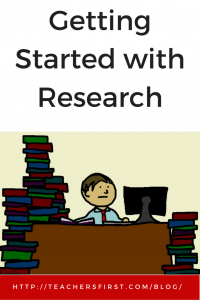 Now that most of us are well into the first quarter of the school year, many teachers have assigned students their first significant formal research assignment for the year. English teachers and school librarians love academic research or at least don’t dread it! Most teachers know they should be giving students an opportunity to work on extensive research projects. Unfortunately, many content area teachers are at a loss when helping to guide students through the process. With the emphasis in many schools on inquiry learning, having a formal process for students to follow is imperative; but students rarely understand the steps in research. College and career readiness standards emphasize student understanding of the research process and creating content. Both ISTE student standards and AASL standards prominently include guided inquiry and research.
Now that most of us are well into the first quarter of the school year, many teachers have assigned students their first significant formal research assignment for the year. English teachers and school librarians love academic research or at least don’t dread it! Most teachers know they should be giving students an opportunity to work on extensive research projects. Unfortunately, many content area teachers are at a loss when helping to guide students through the process. With the emphasis in many schools on inquiry learning, having a formal process for students to follow is imperative; but students rarely understand the steps in research. College and career readiness standards emphasize student understanding of the research process and creating content. Both ISTE student standards and AASL standards prominently include guided inquiry and research.
If you and your students need help getting started, here are some great places for students and teachers to figure out how to do academic research, especially the proper steps.
Many elementary teachers begin explaining research process using the Big 6, Developed by Mike Eisenberg and Bob Berkowitz. The Big6 is a six-stage model to help anyone solve a problem or make decisions by using information, not just formal research.
Carol Kulthau developed her groundbreaking research in the guided inquiry model way before inquiry learning and project based learning became established at many schools. Two places to find out more are at the Rutgers and the Baltimore County Public Schools.
Perhaps you are looking for an online curriculum to teach research. Check out two online interactive sites for students developed by INFOhio. INFOhio is Ohio’s preK-12 digital library that provides access to Ohio-only online reference sources. However, INFOhio’s website contains lots of content for teaching and learning which is free to anyone anywhere. Go! Ask, Act, Achieve, is an interactive online site with activities to teach the research process to students in grades four through ten using the three eponymous steps. The site even includes a helpful LiveBinder teacher’s guide.
INFOhio’s Research4Success, another online tool for 11th grade through the first year of college, divides the process into six steps. An extra benefit is that a teacher can load the six modules into a course management system for blended and online learning.
One more tool from INFOhio, IMatrix takes the guided inquiry process, the Common Core standards, curricular connections and puts them all at the teachers’ fingertips. Search by standard, skill or content area and find cross-curricular connections and resources for teaching the skill for grades K-12. The Dimensions of Inquiry form the basis for IMatrix and the other INFOhio tools.
Creating a “works cited” page or bibliography can be time-consuming and excruciating at times. That is why EasyBib, the free citation generator, seems like a minor miracle to those who are cross-eyed trying to remember where periods and commas go in in the bibliographic listing. Then there are the MLA versus APA questions. A favorite of many English teachers and school librarians is Noodletools. While some of the content is for subscribers, there is plenty of free help for doing research including a citation builder.
How about helping students get organized along with understanding the steps to research? Many students need help with time management to avoid all-nighters and shoddily done final projects. Check out Minitex Research Project Calculator which provides model lessons and a calendar/timeline for students to share via email. Select the type of assignment and due date and the calculator creates a schedule of five steps for completing the project. Each step has helpful information and activities that students may do on their own or teachers can use in class or assign.
For the youngest students, The Kentucky Virtual Library presents “How to Do Research,” which includes an Infographic diagram of the research process and many teacher resources to give students their first formal research experience.
An extremely thorough site that has resources and links for all of the steps in the research process is A Research Guide for Students. The site is appropriate for older students because of the conceptual difficulty level. Teachers will find many helpful ideas and resources here.
The Purdue Online Writing Lab has become the go-to place for writing help and advice. A useful section on Full OWL Resources for Grades 7-12 Students and Instructors has extensive information on the research process, writing, citing sources, and more.
Finally, let me end with a place you might want to begin, a pre-assessment of your students’ information literacy and research skills. Want a way to assess your students’ understanding of the research process? Use TRAILS, the Tool for Real-time Assessment of Information Literacy Skills, before beginning a project. Developed by the Kent State University Libraries, TRAILS is a powerful, free online multiple-choice assessment for grades 3 and up.

